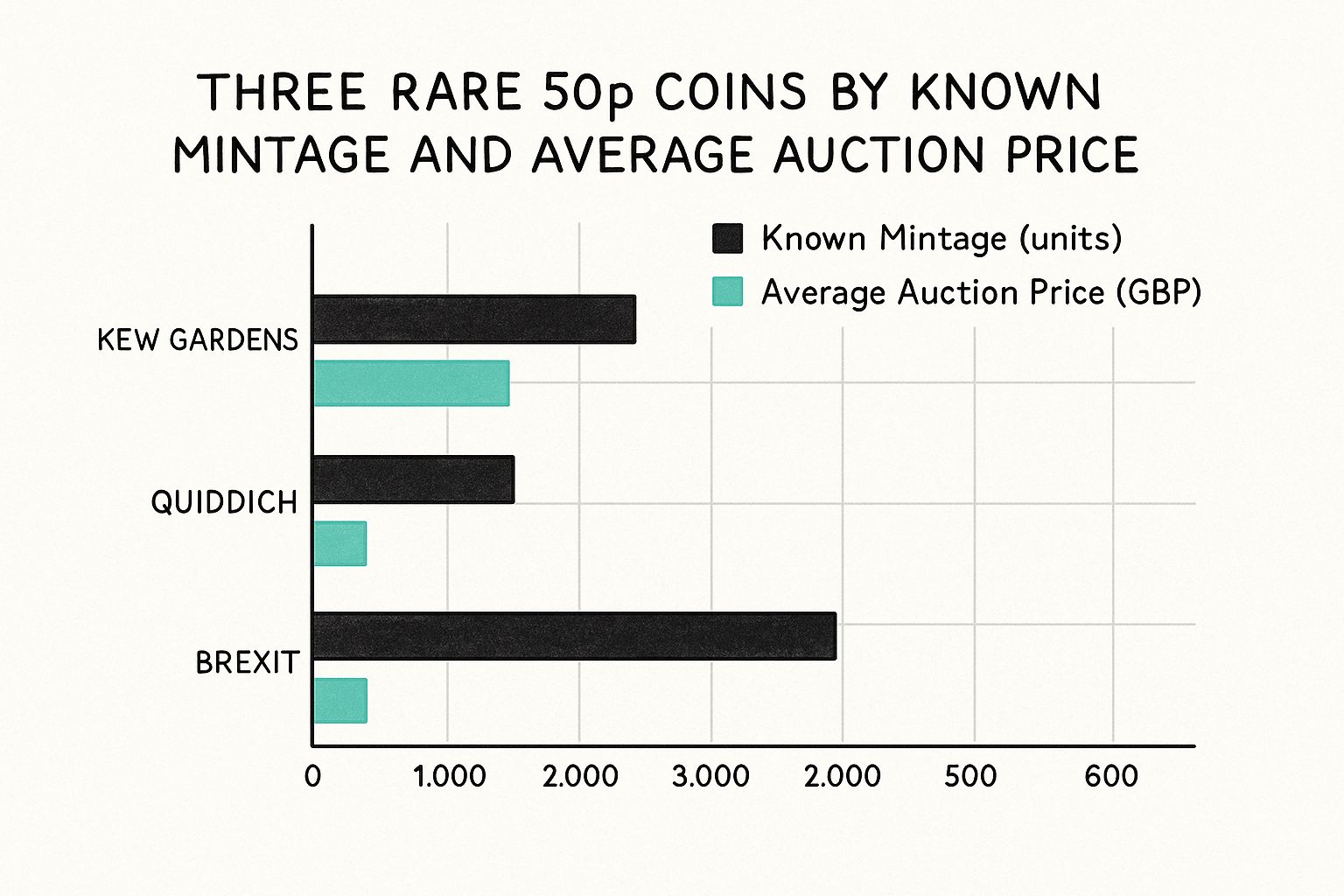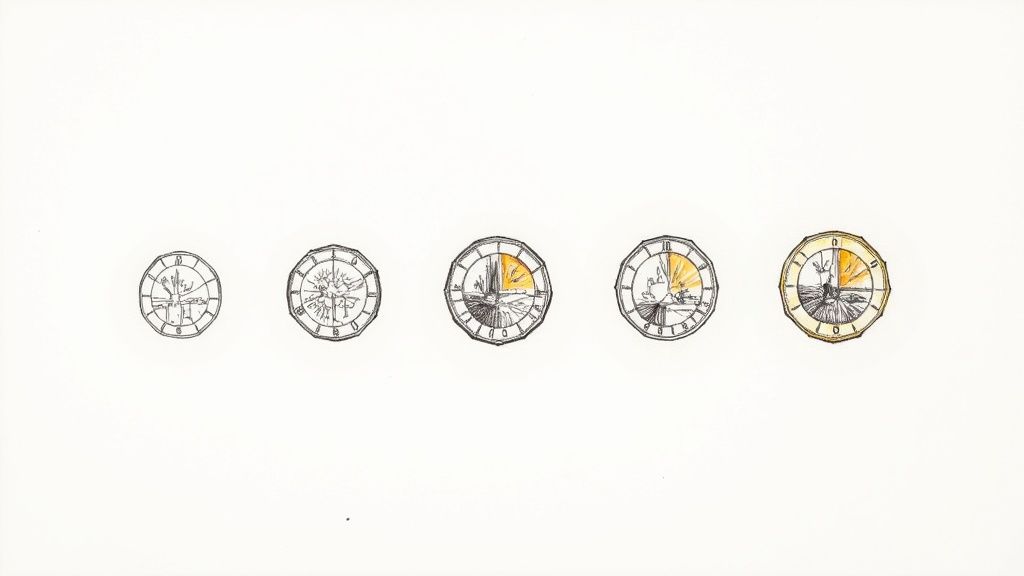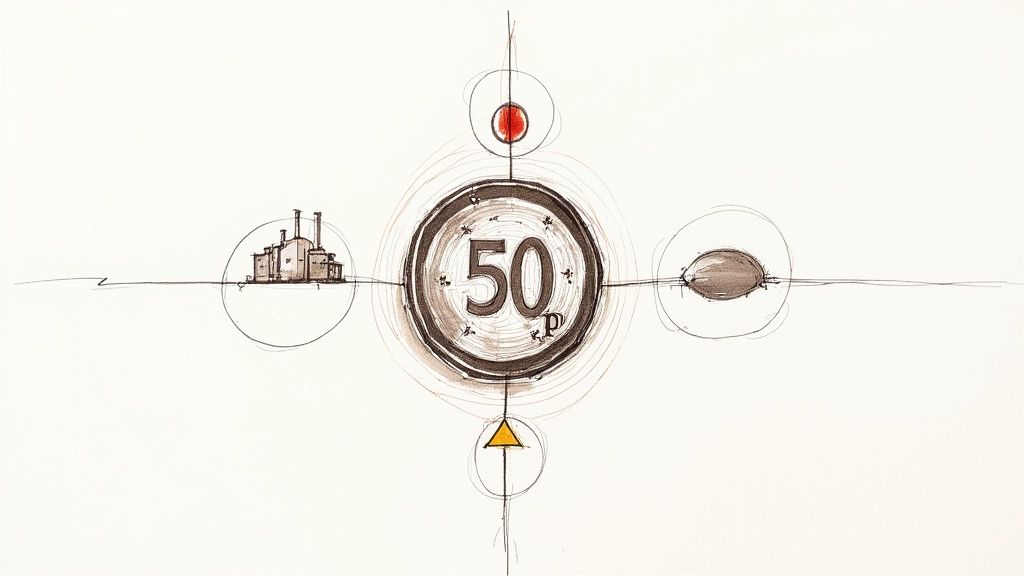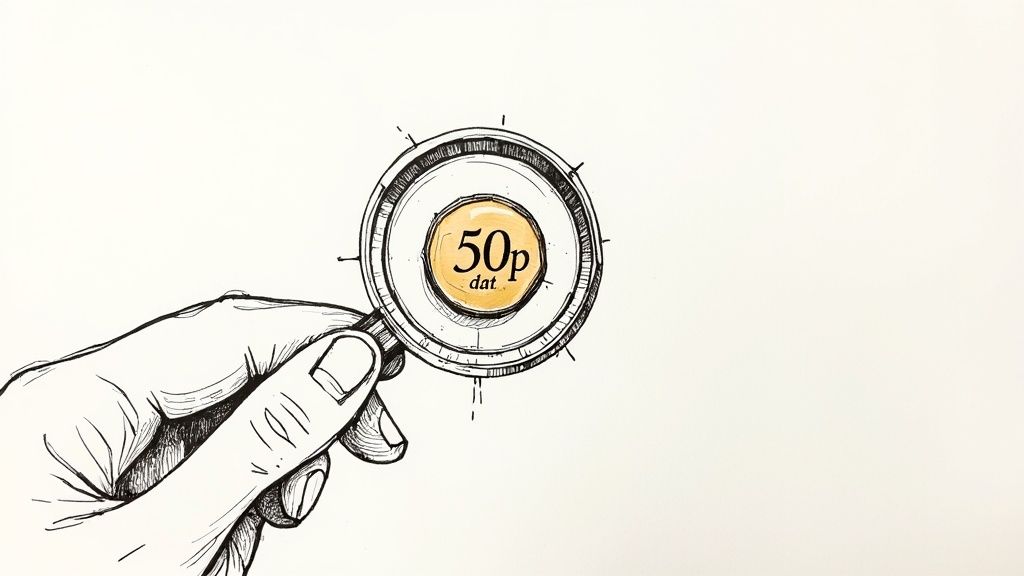Before we jump into the list of the UK's most sought-after 50p coins, it's worth taking a moment to understand why some of these little heptagonal pieces of metal become so valuable. It’s not always about age; there are a few key ingredients that can turn everyday pocket change into a collector’s dream.
Getting a handle on this is your first step to spotting real treasure.
What Makes a 50p Coin Rare and Valuable?
The single most important factor, time and again, is the mintage figure. This is simply the total number of coins of a particular design that The Royal Mint produced and released into circulation.
Think of it like a first-edition book or a limited-run vinyl record. The fewer copies that exist, the more people want them, and the higher the price goes. A standard 50p might have a mintage in the millions, making it just another coin. But a special commemorative one? That could have a tiny run of just 210,000, instantly making it scarce.
Key Drivers of Value
While a low mintage is the headline act, a few other things can seriously ramp up a coin's market price. Knowing what to look for will help you size up any potential finds.
- Historical Significance: Coins that celebrate major national events, big anniversaries, or iconic cultural moments often carry an extra layer of appeal. They tell a story, and that story adds value far beyond the metal itself.
- Design Errors: Believe it or not, mistakes happen—even at a place as precise as The Royal Mint. Coins that sneak out with an error, like a wrong date, a misaligned strike, or even a design that was quickly withdrawn, are exceptionally rare. These "error coins" are often the holy grail for collectors.
- Condition (Grade): A coin's physical state is absolutely critical. An "uncirculated" coin that looks as fresh as the day it was minted will always command a much higher price than a scratched-up, worn-down one that’s been rattling around in cash registers for years.
This image really drives home how mintage impacts value for three well-known rare 50p coins.

As you can see, there's a direct line between a lower mintage figure and a higher sale price. It's the number one rule of thumb in coin collecting.
To get a fuller picture of this iconic coin, you can explore more about the delightful and colourful history of the British 50p coin.
The Kew Gardens 50p: A Modern Legend
For a long time, one coin reigned supreme as the undisputed king of rare 50p pieces: the Kew Gardens 50p. Its story is the perfect showcase of how a special commemorative coin can capture the public’s imagination, sparking a nationwide treasure hunt through our everyday pocket change.

This coin appeared in 2009 to mark the 250th anniversary of the Royal Botanic Gardens at Kew. It features a wonderfully elegant design of the famous Chinese Pagoda, with a twisting vine climbing its way up the structure. While the design alone made it a standout, its real claim to fame is just how few were ever made.
Why Is This Coin So Famous?
The Royal Mint released an incredibly small number of these coins into circulation. With a mintage of just 210,000, the Kew Gardens 50p instantly became a legend in the coin-collecting world. To give you some perspective, most commemorative 50p coins are struck in their millions.
Finding a Kew Gardens 50p is like finding a needle in a haystack; there's roughly only one of these coins for every 300 people in the UK. This extreme scarcity is the primary reason it became the benchmark for rare 50p coins.
This scarcity completely changed the game for collectors. All of a sudden, people across the country were meticulously checking their change, all hoping to spot that iconic pagoda. You could argue this was the coin that truly ignited the modern public's fascination with 50p collecting, proving that real treasure could still be found in your wallet.
The 2009 Kew Gardens 50p remains one of the most sought-after coins in British circulation. Because so many were quickly snapped up by collectors and never saw the light of day, their value has shot up. Today, a coin in good condition can fetch around £120—a pretty staggering return on its 50p face value. You can find more insights on the UK's rarest 50p coins and their values.
How to Authenticate a Genuine Kew Gardens 50p
Unfortunately, where there's high value, there are fakes. The immense popularity of the Kew Gardens 50p has led to a flood of counterfeits on the market, so it’s crucial to know what you’re looking for.
- Check the Date: A genuine circulating Kew Gardens 50p must be dated 2009. The Royal Mint did issue a 2019 version, but this was only included in commemorative sets and was never intended for circulation.
- Examine the Queen's Portrait: On the obverse (the "heads" side), the point of the Queen's neck should point directly at the middle of the 'P' in 'PENCE'. This alignment is often wrong on fakes.
- Inspect the Pagoda's Base: On a real coin, the bottom of the pagoda is clear and distinct from the coin's rim. Counterfeits often have a thicker, less defined base that almost bleeds into the edge.
By carefully checking these small details, you can give yourself a much better chance of avoiding a convincing but worthless copy. It’s the best way to ensure your collection contains only the real deal.
Spotting the Newest Rare 50p Coins
For years, the Kew Gardens 50p has been the undisputed king of rare coins. But the world of coin collecting never stands still. New designs are always making their way into our pockets, and every now and then, a fresh release arrives with such a low mintage that it becomes an instant legend. It’s a brilliant reminder that you don't need to find a coin from decades ago to strike gold.

That exact thing happened very recently, completely shaking up the rarity charts and giving collectors a thrilling new treasure to hunt for. The coin that's stolen the crown is a beautifully designed piece with a fascinating story to tell.
The Atlantic Salmon: A New Reigning Rarity
Meet the new champion of scarcity: the 2023 Atlantic Salmon 50p. This coin swam into circulation in late 2023 and immediately made waves in the numismatic community. It was released as part of the first-ever definitive coin set to feature the portrait of King Charles III, marking a huge moment in the history of British coinage.
The design itself is part of a wider series celebrating Britain’s flora and fauna, shining a spotlight on species facing conservation challenges. Each coin tells a piece of the UK’s natural story, from the oak leaf to the puffin, with the Atlantic Salmon representing our precious river ecosystems.
But its historical and environmental importance isn't what makes it the new must-have piece. The reason comes down to pure, simple numbers. With an astonishingly low mintage of just 200,000, the 2023 Atlantic Salmon 50p has officially become the rarest 50p coin in UK circulation. This tiny production run puts it firmly ahead of even the legendary 2009 Kew Gardens 50p. If you want to dive into the data, you can learn more about its rank on the scarcity index.
Why Its Mintage Matters So Much
To really get your head around why this coin is so special, you need to see the numbers side-by-side with other famous rarities. The comparison truly highlights the scale of its scarcity.
- 2023 Atlantic Salmon: 200,000 minted
- 2009 Kew Gardens: 210,000 minted
- 2011 WWF (World Wildlife Fund): 3,400,000 minted
- 2017 Sir Isaac Newton: 1,801,500 minted
This shows the Atlantic Salmon 50p isn't just a fraction rarer than the Kew Gardens coin; it has set a completely new benchmark. Its release proves that The Royal Mint is still capable of producing coins with extremely limited mintages, which keeps the hobby exciting for all of us.
For collectors, this is fantastic news. It’s confirmation that the hunt for rare 50p coins isn't just about looking back at old classics. It’s a living, breathing pursuit where the next great find could be sitting in the very next handful of change you get. The Atlantic Salmon 50p is a testament to that thrilling possibility.
The Hunt for Rare Olympic 50p Variants
The London 2012 Olympics wasn't just a spectacular sporting event for the UK; it kicked off a nationwide collecting craze. The Royal Mint issued a massive set of 29 unique 50p designs, each celebrating a different Olympic and Paralympic sport. Almost overnight, the entire country seemed to be checking their change, hoping to complete the full set.

While most of these coins were churned out in their millions, a few hidden gems are tucked away within the series. I'm not just talking about the designs with lower mintages. I'm talking about the real prizes: the rare variants. These are the coins with small design errors or alterations that were quickly spotted and corrected by the Mint. It's these accidental rarities that have become the holy grail for any serious collector.
The Famous Aquatics 'Lines Over Face' Error
If there's one undisputed champion of the Olympic 50p rarities, it has to be the original Aquatics coin. The very first version of this design showed a swimmer with lines of water streaming right across their face, making it a bit hard to see. The Royal Mint agreed the design wasn't clear enough and pulled it from production almost immediately.
They quickly swapped it for a revised version where the swimmer's face is clearly visible, breaking the surface of the water. This rapid change unintentionally created a collector's dream. The original 'lines over face' edition is now one of the most celebrated error coins out there, turning a simple piece of change into numismatic gold.
The rarity of this coin really can't be overstated. It’s a perfect example of how a simple minting correction can create incredible value, turning what was once a design flaw into a highly sought-after collectible.
Among the very rarest 50p coins from the entire London 2012 collection is the Aquatics 50p with its famous 'lines over face' mistake. It's estimated that only about 600 of these original error coins ever slipped into circulation, making it one of the most valuable and difficult-to-find 50p coins in existence. You can read more about the history of this collectible 50p coin and its journey to fame.
Other Notable Olympic Variants
While the Aquatics coin understandably grabs the headlines, it’s not the only variant from the 2012 series worth hunting for. Another fantastic example to keep an eye out for is the Football 50p, which features a diagram explaining the offside rule.
-
The Original 'Offside Rule' Football 50p: The first design had less defined lines in the diagram. It was later updated to make the explanation clearer. While the difference is subtle, the original version is the scarcer of the two and commands a higher price among collectors in the know.
-
Distinguishing the Versions: Spotting the rare Football 50p requires a sharp eye, or perhaps a magnifying glass. The key is to compare the detail and thickness of the lines in the diagram with photos of the more common, revised version.
These variants are proof that even within a huge collection like the Olympic series, genuine rarities can be hiding in plain sight. It’s a great reminder to always take a second look at your change—you never know when you might be holding a small piece of Olympic history worth a small fortune.
How to Identify and Value Your 50p Coins
So, you think you’ve struck gold with a 50p from your change. What’s next? The real fun begins: playing detective to confirm if it’s genuinely one of the rare ones and figuring out what it’s actually worth. This is a skill every collector needs to master.
First things first, you'll need a couple of simple tools. A decent magnifying glass or, even better, a jeweller's loupe is a must-have. It’ll help you spot the tiny details that can mean the difference between a common coin and a real find. It's also wise to have a reliable online resource handy, like The Royal Mint's mintage figures page, for a quick check on how many were made.
Understanding Coin Condition and Grade
The physical state of your coin—what collectors call its grade—has a massive impact on its value. It’s simple, really: a shiny, pristine coin that looks like it just rolled off the press is always going to be worth far more than a scuffed-up, worn one that’s been rattling around in pockets for years.
Collectors have a whole scale for this. While it gets pretty detailed, you only need to know the basics to get started:
- Brilliant Uncirculated (BU): This is a perfect coin. It has no signs of wear and looks exactly as it did the day it was minted. You usually find these in special collector sets.
- Good to Fine: This coin has clearly been in circulation and shows moderate wear, but the main design is still sharp and easy to see. This is the state of most coins you’ll find in your change.
- Poor: A coin that’s seen better days. It's heavily worn, and the date or key parts of the design are tough to make out. These coins are rarely worth more than their face value.
Learning to spot the subtle differences in wear is everything. A Kew Gardens 50p in Brilliant Uncirculated condition could fetch over £200, but that very same coin in Poor condition might only get you a fraction of that.
If you want to get a bit more technical, it's well worth exploring the full European coin grading system explained in more detail.
Getting a Realistic Valuation
Once you’ve identified the coin and have a good idea of its condition, it’s time to work out what someone might pay for it. The trick here is to look at what similar coins have actually sold for, not just the ambitious prices people are asking for.
Online marketplaces like eBay are a fantastic place to start your research. Just make sure you use the "sold items" filter to see the real-world prices that coins in a similar grade to yours have recently achieved. A recent coin catalogue or a quick chat with a reputable dealer can also give you an expert's view. And don't underestimate the power of community—joining collector forums or social media groups is a brilliant way to get advice from experienced numismatists and build a realistic picture of your coin's true worth.
Building Your Collection: Where to Find Rare Coins
Finding the rarest 50p coins is part of the thrill of collecting. It’s a game of patience, a little bit of strategy, and sometimes, a stroke of pure luck. While it might feel like a treasure hunt, there are several well-trodden paths you can take to track down those elusive pieces, starting with the easiest one of all.
The classic approach is what we call “coin hunting”—the simple art of meticulously checking your everyday change. You can take this a step further by visiting your local bank or Post Office to swap notes for sealed bags or rolls of 50p coins. This seriously ups your volume and boosts your chances of spotting something special, all without costing a penny more than face value.
Expanding Your Search Beyond Pocket Change
While sifting through your change is exciting, hunting for a specific coin often requires a more focused game plan. Online marketplaces are a goldmine for collectors, but you need to tread carefully to make sure you're getting the real deal.
-
Online Marketplaces: Sites like eBay are swimming with listings for rare 50p coins. To protect yourself, always check a seller’s feedback score and read their most recent reviews. Be sceptical of listings that use stock photos instead of pictures of the actual coin, and always compare the asking price to recent sold listings to avoid paying over the odds.
-
Auctions and Dealers: For the really high-value coins, turning to professional dealers and auction houses gives you a much greater sense of security. These experts have reputations to protect and can often provide provenance for the coins they sell. If you fancy a bit of bidding, it's well worth exploring the top online coin auctions to find your treasure.
Connecting with the wider collecting community is one of the most rewarding ways to build your collection. It provides access to expert knowledge and opportunities for fair trades or purchases.
Getting involved with others who share your passion can open up a world of new opportunities. Coin fairs, local collecting clubs, and online forums are fantastic places to meet specialist dealers, swap duplicates with fellow collectors, and get trusted advice on your next purchase. This community approach doesn't just help you find rare coins; it makes the whole hobby that much more enjoyable.
Answering Your Top Questions on Rare 50p Coins
Dipping your toes into the world of 50p collecting can throw up all sorts of questions, especially when you're just starting out. Let's tackle some of the most common queries we see from new and experienced collectors alike.
What Is the Rarest 50p Coin?
Right now, the coin holding the title for the rarest 50p you might find in your change is the 2023 Atlantic Salmon 50p. With a mintage of just 200,000, it’s a seriously tough one to track down. It just about pips the legendary 2009 Kew Gardens 50p to the post, which had a mintage of 210,000.
But that’s not the whole story. The absolute scarcest coins are often the ones that were never meant to be—the error or withdrawn coins. Take the original 2012 Aquatics 50p, for example. The first version, with water lines flowing over the swimmer's face, was quickly withdrawn. It's thought that only around 600 ever escaped into circulation, making them incredibly rare and sought after.
How Much Is My Kew Gardens 50p Worth?
This is a big one, and the answer always comes down to condition. If you find a 2009 Kew Gardens 50p that’s been through the wars a bit—showing the usual scrapes and dings of circulation—it might still sell for around £120.
However, if you have a pristine, uncirculated example that looks like it just left the mint, its value can shoot up significantly, often fetching over £200 at auction. The best way to get a feel for the current market is to check the 'sold' listings on platforms like eBay.
Are All Commemorative 50ps Valuable?
Not at all, and this is probably the biggest misconception for newcomers. Just because a coin is 'commemorative' doesn't automatically make it rare or valuable. Many special 50p designs, like the 2020 Brexit 50p, were struck in massive numbers—over 10 million in that case.
The only thing that truly matters is the mintage figure. A coin is only valuable if it’s scarce. If millions were made, it’s common and will likely only ever be worth its face value of 50p.
Where Should I Sell My Rare 50p Coins?
When it comes to selling, you've got a few solid options, each with its own pros and cons.
- Online Marketplaces: eBay is the go-to for most people. It gives you access to a huge pool of potential buyers and a good chance of getting a fair price, but you’ll have to account for their fees.
- Reputable Coin Dealers: A specialist dealer offers a quick and guaranteed sale. They’ll handle the authentication and give you an immediate offer, though it might be a little less than you’d get from a private sale.
- Collector Groups: Don't overlook online forums and social media groups. They are fantastic places to connect directly with fellow collectors who might be looking to buy or trade for the exact coin you have.
At Cavalier Coins Ltd, we provide a trusted platform for both new and expert numismatists to build their collections with confidence. Explore our extensive selection of rare coins from around the world today at https://www.cavaliercoins.com.

